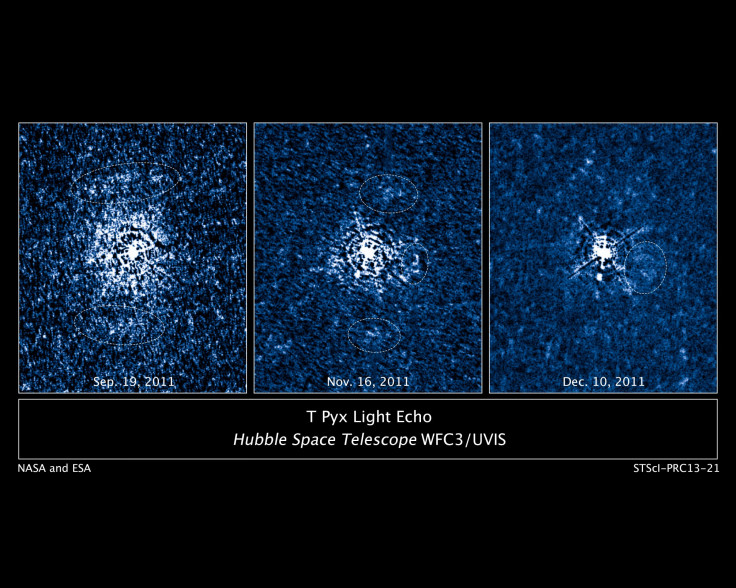Erupting Star, T Pyx, Fallout Captured By NASA’S Hubble Space Telescope [PHOTO]

The aftermath of a nova, or a white dwarf star explosion, was mapped by NASA’s Hubble Space Telescope. The Hubble photos create a 3D map of debris ejected into space by the explosion.
Over a four-month period, Hubble mapped images of T Pyxidis, or T Pyx, a binary star system located 15,600 light-years from Earth and captured photographs of the fallout from a recent nova. T Pyx consists of a white dwarf and a larger, but less massive, star and is a recurrent nova, with star explosions every 12 to 50 years. The most recent nova occurred in April 2011, and Hubble was used to map out previously ejected material from past novae.
The light from the April 2011 nova illuminated the previously ejected material in sequence, from closest to Earth to farthest from Earth. According to the NASA release, this phenomenon is called "light echo," and it enabled researchers to discover how ejected material behaves. Based on their observations, astronomers discovered the ejected material from T Pyx formed a disk, not a sphere, and instead of being ejected outward from the explosion, the debris stayed within the star system.
Team member Stephen Lawrence, from Hofstra University, compared the effect of the recent T Pyx explosion to that of fireworks. “We've all seen how light from fireworks shells during the grand finale will light up the smoke and soot from shells earlier in the show,” Lawrence said. “In an analogous way, we're using light from T Pyx's latest outburst and its propagation at the speed of light to dissect its fireworks displays from decades past.”
The team’s research is the first time a nova’s ejected material and surrounding environment have been studied in three dimensions, NASA said. The team’s research was also able to better estimate T Pyx’s distance from Earth. Scientists had previously estimated T Pyx’s distance between 6,500 and 16,000 light-years from Earth, but researchers now believe the nova is about 15,600 light-years away. The research will be published in Astrophysical Journal Letters.
Novae occur when there's enough hydrogen on the surface of a white dwarf star to trigger an out-of-control nuclear reaction. In T Pyx’s scenario, the white dwarf pulls enough hydrogen and other material from its companion star to trigger an explosion. T Pyx is just one of 10 known recurrent novae, with the star system among the most active of the group.
© Copyright IBTimes 2024. All rights reserved.








